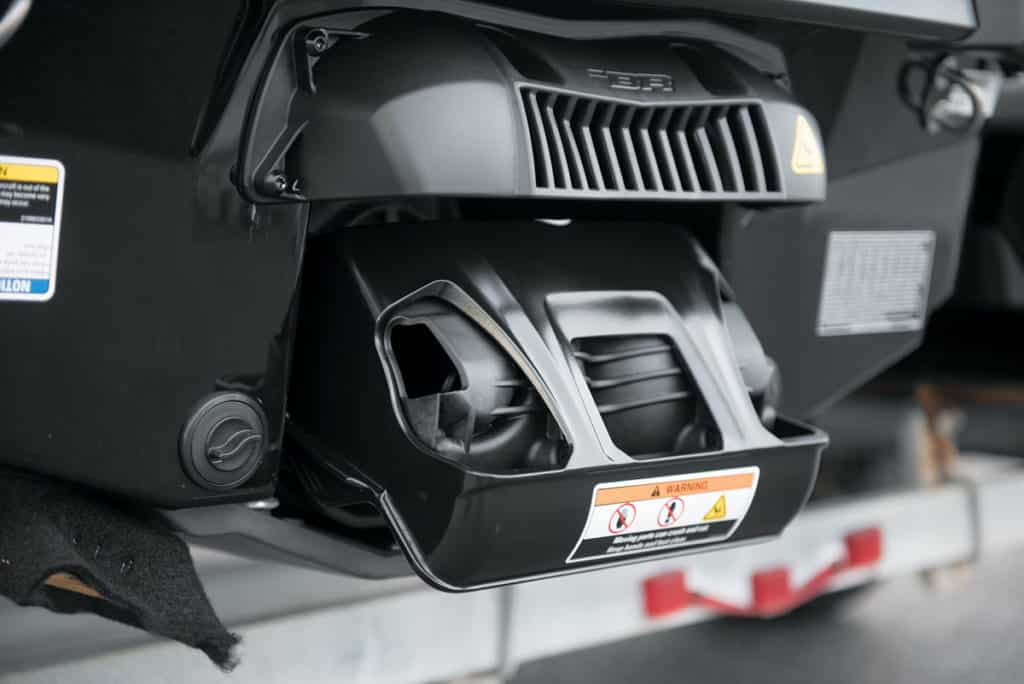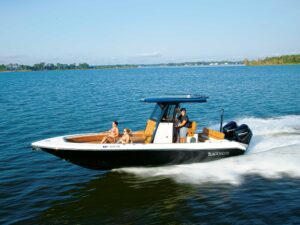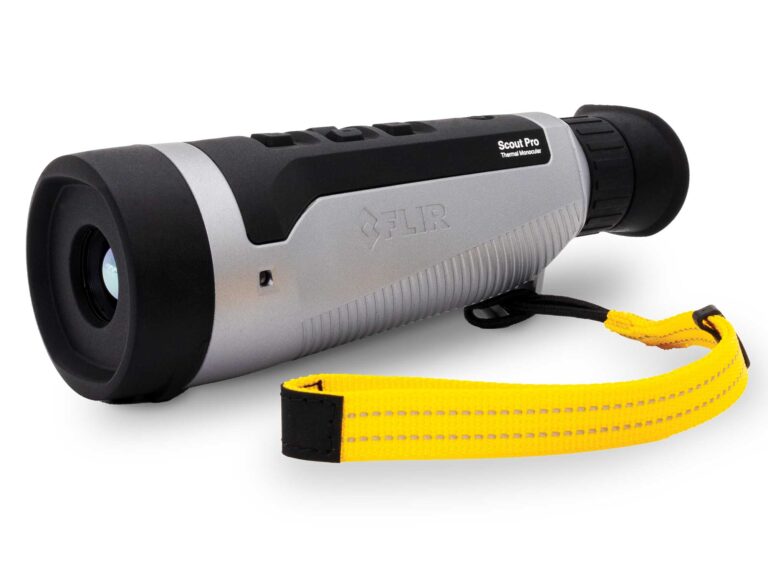
Personal watercraft have long suffered from less control than their mainstream boating counterparts. Chalk it up to the nature of jet propulsion. While their thrust was constant, early models were always in forward motion, making low-speed maneuvers — like docking — somewhat dicey. Though the introduction of reverse buckets in 1990 changed things dramatically, jet-powered craft still lacked the precision offered by a prop-propelled boat’s gearshift. That all changed in late 2008 with the introduction of Sea-Doo’s Intelligent Brake and Reverse system (iBR).
The company’s iBR revolutionized the industry by doing two things. First, it allowed a PWC to finally have that true feeling of forward, neutral and reverse. Suddenly a Sea-Doo remained stationary when started at the dock or launch ramp and easily shifted into the appropriate motion. Second, it gave Sea-Doo something no mainstream boating counterpart shared: the next best thing to a car’s brakes. The system provided actual stopping power at speed, rapidly decelerating an equipped craft in roughly half the distance previously required. Best of all, it accomplished all these actions while keeping eyes focused on the water and hands on the handlebars.
Though competitors initially scoffed, Yamaha introduced its own take on electronically enhanced control in 2015. RiDE, or Reverse with Intuitive Deceleration Electronics, gave WaveRunner models similar capabilities. Suddenly the vast majority of new personal watercraft on the market had control that rivaled, and arguably exceeded, anything else in the boating market.
How do these systems work, and how do they compare? I arranged an in-depth test to get the scoop on this latest generation of control freaks.




Similarities and Differences
Though there are distinct differences between each company’s approach to this enhanced control, overall the two are markedly similar. Both use a modified version of the jet pump’s reverse bucket to drop into and deflect the flow of thrust as it exits the pump. Deflecting that thrust at high speed provides slowing power, causing the craft to rapidly decelerate. Deflecting that thrust at low speed allows the craft to mimic the sensation of gears. A partial deflection keeps the craft in a relatively neutral position. A full thrust deflection causes the craft to move in reverse, and input at the handlebars influences direction. In each case, the bucket is electronically linked via the craft’s electronic control unit (ECU) to a handlebar-mounted control lever opposite the throttle.
As to their differences, let’s start with the philosophical. In addition to reverse, Sea-Doo markets iBR as a true braking system. “Being in control makes any experience more fun,” explains Sea-Doo media relations rep Tim McKercher. “A brake system that is as easy to operate as a bicycle brake rounds out the control elements people are accustomed to with other vehicles. Having the ability to stop at your discretion and transition from neutral, forward or reverse without ever having to take your eyes off the situation around you are key features to elevate the Sea-Doo experience.”
Yamaha, in contrast, avoids any reference to braking with RiDE. Instead it promotes dual throttle controls, one to accelerate the boat in forward and one to slow the craft or accelerate it in reverse. It provides “a complete driving experience and includes features customers will use the entire time they’re on the water,” says communications manager Andrew Cullen. “RiDE is the only dual throttle system allowing customers to effortlessly switch between forward, neutral and reverse without shifting or removing your hands from the handlebars. RiDE also includes deceleration capabilities along with the ability to steer while decelerating, thanks to a patented, side-thrust bucket design.”

The designs reflect each company’s philosophy. Sea-Doo’s iBR closely mimics the feeling of traditional gears, with the rider using the iBR lever to shift the boat between forward, neutral and reverse at idle speed and squeezing the throttle to provide power. When braking at speed, iBR initially directs the water flow upward, pulling the craft from the rear and using the diverted water to act as a visual braking signal. Once the system detects the drag has produced its maximum stopping power (typically below 10 mph), reverse thrust completes the process.
On the other hand, Yamaha’s RiDE eschews any feeling of a gear’s detent, providing a more fluid transition between motions. Pushing the throttle provides forward acceleration and applying force to the RiDE lever overrides that throttle to deliver power in reverse. You can use that power at speed to rapidly decelerate, at lower rpm to maneuver in tight confines, and in reverse to back away with throttle.

While both machines start in neutral, a Sea-Doo needs to be consciously shifted into neutral from forward or reverse; a Yamaha will assume a neutral stance whenever both levers are released.
Testing Methodology
For the purposes of our comparison, I assembled a trio of riders with varying experience. I’m an industry veteran with a wealth of time on each system. Joining me were Chris Krall, an avid stand-up PWC enthusiast, and Kevin McAuliffe, a traditional boater with no PWC experience. In addition to my own observations, I looked to both men to offer their insights on each system’s intuitiveness, ease of use and effectiveness as we ran through a number of scenarios, including launching and loading at the ramp, parallel parking within set confines at the dock, braking/decelerating at speed and the overall ride experience.
We also looked to produce some cold, hard numbers. Until now, deceleration distances and times associated with each system had never been definitively tested. Rather than a less precise buoy course and estimation, we utilized a Racelogic VBOX Sport, a GPS-based device that recorded a wealth of data, including precise measurements of just how far each boat traveled after releasing the throttle and how much shorter that distance became after applying the iBR or RiDE levers.

Using the same course with a fixed buoy, we ran tests at both 50 and 30 mph on two comparable, recreational-category craft: the Sea-Doo GTI 130 and Yamaha VX Deluxe. Data gathered included each craft’s normal coasting distance after the throttle was released at each speed, as well as both distance and time after applying the iBR or RiDE lever. In order to smooth out any error created by variable throttle sensitivity, wind shifts or other variables, we ran each test a minimum of three times for each PWC and averaged the results. As virtually all deceleration happens by the time each craft reaches idle speed — and no watercraft truly becomes stationary in open water — 5 mph was chosen as the final speed. The results follow.
Test Results
Testers were unanimous in their opinions that, while intuitive, each system had a brief learning curve, particularly with close-quarters, low-speed maneuvering. McAuliffe felt he quickly mastered each in open water while using a foam buoy as a target but soon discovered a bias in his test.
“Because I knew the buoy was forgiving and I was alone in open water with no witnesses or distractions, I didn’t second guess or panic. I just used the controls to perform a task,” McAuliffe says. “Move to the imposing, stationary dock with witnesses, and your brain starts to scream, ‘Don’t hit the dock, don’t scratch the boat, don’t screw up,’ which leaves fewer brain cells to actually perform the task of docking.”
Still, within five minutes of close-quarters practicing, both guest testers were demonstrating the systems’ relative ease of use. The best advice: “With both units, less is more,” Krall notes. “The less throttle you apply, the easier it is to dock.”

Sea-Doo’s precise, gearlike approach to forward, neutral and reverse initially inspires more confidence in confined spaces, particularly since Yamaha allows the engine to rev higher (3,500 versus 2,500 rpm) in reverse. With time, however, our guest riders learned to feather the Yamaha’s power and began to prefer RiDE’s simplicity.
“It’s nice to have one lever to apply the forward throttle and the other to apply reverse,” Krall says. “If more reverse power is needed, simply squeeze the reverse lever more. With Sea-Doo, I had to make sure it was in reverse with the iBR lever before applying throttle for more help.” As the thrust exits the sides of the Yamaha’s reverse bucket, the PWC also proved more agile and maneuverable in reverse.

Both newcomers learned that neutral is your best friend in tight confines. In terms of braking or deceleration, all testers noted that iBR provided the greatest stopping power. The system produces a more abrupt deceleration, accompanied by the visual alert when the water diverts upward. Though the original iBR system tended to cause craft to dive slightly at the bow during hard braking, the second-generation version (introduced in 2016) allows the boat to stay mostly level. RiDE produces a less abrupt deceleration with no visual alert, but the boat remains completely level in the water.

Data recorded by the VBOX Sport confirmed these impressions. In terms of stopping distance, both craft naturally coasted from 50 to 5 mph after the throttle was released in approximately 250 feet over 7.5 seconds. Activating iBR or RiDE, that distance dropped to 143.2 feet over 4.8 seconds for the Sea-Doo and 177.6 feet over 5.3 seconds for the Yamaha. As you would expect, the effect is less pronounced at 30 mph. In this scenario, both craft produced nearly identical results, traveling an average of 92 feet in just over 4 seconds.

Conclusions
Clearly the ability to slow your momentum, or brake, is useful. While experienced riders may ultimately rely more on power and maneuverability to avoid a mishap, novice riders are more apt to intuitively “reach for the brakes,” like they would on a bicycle or motorcycle. Others may just wish to slow the momentum before a turn or when approaching a no-wake zone. In this sense, deceleration can be a powerful tool.
I continue to argue, however, that the greatest strength of both iBR and RiDE is in low-speed maneuvering. Giving the PWC operator the options of forward, neutral and reverse while eyeballing the water and without requiring a hand to leave the handlebars and reach for a console-mounted reverse lever increases the usability of the craft by tenfold. It takes the stress out of docking, the tension out of maneuvering around a crowded marina, and opens up the enjoyment of PWCs to a much wider group of boaters.
In short: Control freaks rejoice! The newest generation of PWCs places you firmly in command on the water.









